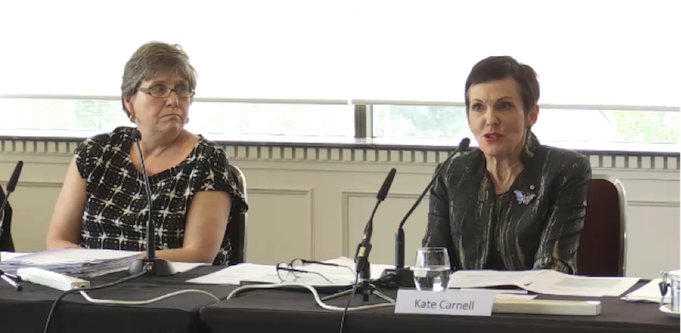
Anne Scott and Kate Carnell during the ASBFEO hearings.
Small business ombudsman Kate Carnell has labelled the banking industry’s response to recommendations from her small business lending inquiry as “feeble”.
On Friday the Australian Bankers’ Association (ABA) released its response to the 12 recommendations made by the Australian Small Business and Family Enterprise Ombudsman’s (ASBFEO) report into lending practices, released in February.
The ABA supported 11 of the 12 recommendations, but introduced a number of stipulations and “caveats” around the ombudsman’s recommendation for “covenant light” contract terms for small business loans $5 million or under.
Carnell had recommended “non-monetary” default clauses be removed from all small business contracts for loans of up to $5 million. The banking sector has given in principle agreement, but wants to cap the loan amount at $3 million.
“For new or renewed contracts, banks will expand the definition of small business beyond what is required by law so that ‘covenant light’ contracts apply to businesses with total loans under $3 million. This will be done by no later than the end of 2017,” ABA chief executive Anna Bligh said in a statement.
The ABA specified it considers a small business to be either under 20 employees, under $10 million in turnover, or to have a total credit exposure to credit providers, including “related entities”, of under $3 million.
Speaking to SmartCompany, Carnell criticised the specifications made by the ABA, referring to roundtable conversations the ASBFEO had with the major banks last year.
“When we talked to the banks, they told us there was no way they could tell how many employees a business had at any point in time,” Carnell said.
“The only way they could identify a small business is by the size of the loan. They said this to us.”
Carnell notes the 20-employee specification only applies to “quite small businesses”, and believes defining a small business has “moved past that”.
“The ATO has gone to $10 million as a definition, and my office uses 100 employees or less as a definition,” she says.
“It’s also quite dumb to have the $10 million in turnover specification and the under 20 employees specification in the same space.”
“It looks to us the ABA wants to significantly limit the number of SMEs loans are available to.”
Carnell also highlighted the issues surrounding the ABA’s modifications around a business’ total credit exposure (TCE), criticising the stipulation that includes a business’ related entities.
These entities would include business partners, husbands or wives, people with shares in a business, or any board member.
“TCE is limited to $3 million because businesses with TCE above this threshold can require more tailored credit facilities. They require more sophisticated risk management including greater reliance on the regular monitoring of the performance of the business,” the ABA said in its response.
Response could “severely limit” loans
Carnell believes this could severely limit the amount of businesses able to get small business loans under the ABA’s recommendations.
“What about business owners with partners who also own a business? It’s just attempting to dramatically reduce the number of small businesses who could avail themselves of these improved contract terms. We think it’s pretty feeble, really,” she says.
The ABA claims the $3 million TCE limitation would cover “in excess of 95% of business covers”, a number that Carnell finds hard to believe.
“I can’t see where they got this 95% figure from, I’m yet to be convinced,” she says.
As for the rest of the recommendations, Carnell is happy the ABA supports them “in principle”, but awaits the revised version of the Code of Banking Practice due towards the end of the year.
“One thing I’m really positive about is the ABA putting a deadline of the end of the year for a revised Code. Traditionally these things take an extraordinarily long time to be put into practise,” she says.
“We’ll be keen to see our recommendations put in place.”
Carnell also welcomes the ABA’s decision to work with ASIC to get the Code approved, believing this will mean the code is “measurable and enforceable”.
“They’ll need to work closely with ASIC, which we’re positive about, but I am concerned when we see the ABA watering down what a small business is defined as,” she says.
“That will be translated into the code if it continues like this, which is not the way to go.”
SmartCompany contacted the ABA but was not provided with a response.
Never miss a story: sign up to SmartCompany’s free daily newsletter and find our best stories on Twitter, Facebook, LinkedIn and Instagram.


COMMENTS
SmartCompany is committed to hosting lively discussions. Help us keep the conversation useful, interesting and welcoming. We aim to publish comments quickly in the interest of promoting robust conversation, but we’re a small team and we deploy filters to protect against legal risk. Occasionally your comment may be held up while it is being reviewed, but we’re working as fast as we can to keep the conversation rolling.
The SmartCompany comment section is members-only content. Please subscribe to leave a comment.
The SmartCompany comment section is members-only content. Please login to leave a comment.